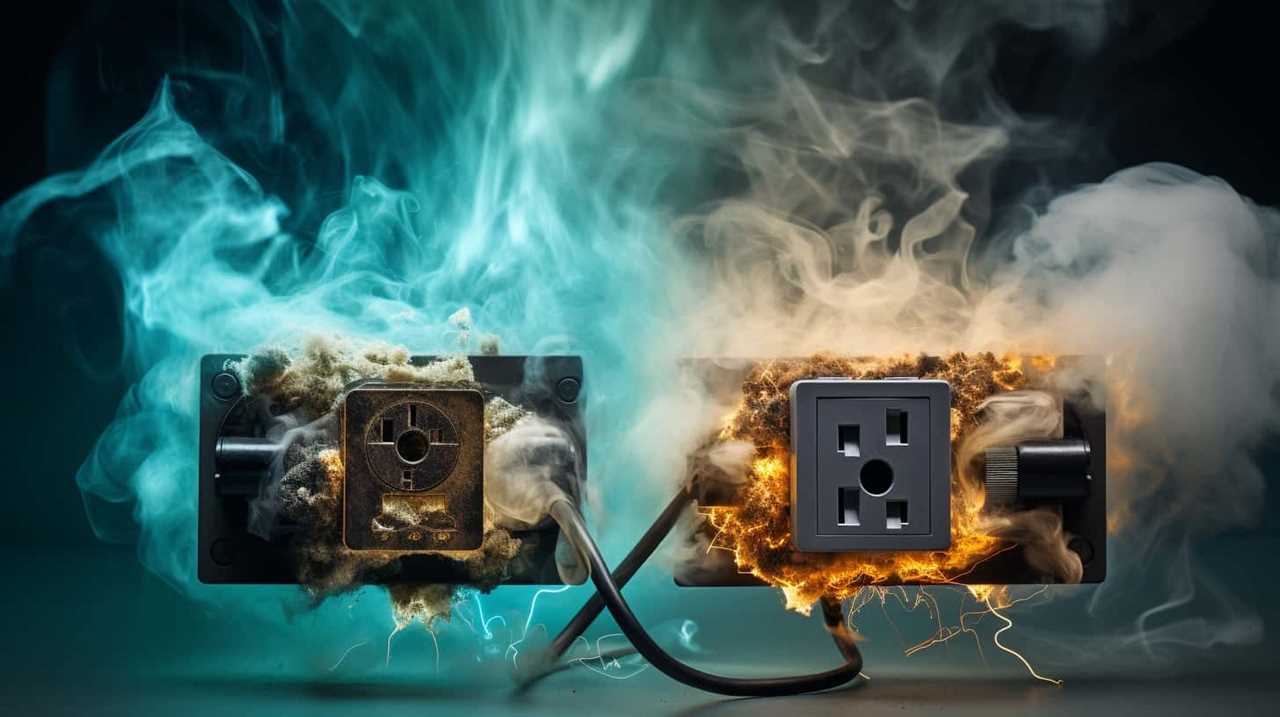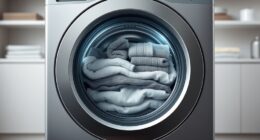If your Whirlpool dryer's making a screeching noise, it's often due to worn idler pulleys or drum rollers. Start by checking the idler pulley for wear or misalignment, as this can affect belt tension. Inspect drum rollers for damage and verify they're well-lubricated. If either seems faulty, replace them—idler pulleys usually cost around $25, while drum rollers also hover near that price. Don't ignore these signs, as they can lead to bigger issues. By addressing these components now, you can restore quiet operation and extend your dryer's lifespan. Discover more troubleshooting tips to keep your dryer running smoothly!
Key Takeaways
- Inspect the idler pulley for wear; a worn pulley can cause screeching due to improper tension on the drive belt.
- Check drum rollers for damage or lack of lubrication, as worn rollers create friction and noise during operation.
- Ensure the dryer is level to prevent unnecessary vibrations and noise while running.
- Look for trapped foreign objects in the drum that may cause squeaking sounds during the drying cycle.
- Regular maintenance, including lubrication and part inspections, can prevent future screeching issues and extend your dryer's lifespan.
Understanding Normal Dryer Sounds

When you run your Whirlpool dryer, it's important to recognize the sounds it makes to guarantee everything's working smoothly. You'll notice a low humming noise from the motor, which is a typical and normal sound during operation. This consistent hum indicates that the motor is functioning properly.
Additionally, the blower wheel generates a rhythmic sound as it rotates, another sign of normal operational sounds. Being aware of these normal sounds makes it easier for you to identify when something might be off.
Normal operational sounds are generally quiet and consistent, differing considerably from louder or irregular noises that may signal a malfunction. By understanding these typical sounds, you can better assess your dryer's health.
Recognizing the difference between normal and abnormal sounds is essential for timely diagnosis and maintenance of your dryer. If you hear any unusual noises, such as clanging or grinding, it's worth investigating further.
This awareness can save you from more extensive repairs down the line, ensuring your Whirlpool dryer continues to operate efficiently.
Common Causes of Screeching

If your Whirlpool dryer is screeching, you might want to check the idler pulley and drum rollers.
Worn idler pulleys can lose tension on the drive belt, while damaged or unlubricated drum rollers struggle to support the drum's rotation.
Addressing these issues can help restore the quiet operation you expect from your dryer.
Idler Pulley Issues
The idler pulley plays an essential role in your Whirlpool dryer by maintaining tension on the drive belt, and issues with this component can lead to annoying screeching noises during operation.
If you notice a persistent screeching sound, especially when the dryer is loaded, it could indicate a problem with the idler pulley.
Worn or damaged idler pulleys often result in improper belt alignment, which can cause additional strain on the motor. This not only leads to the squeaking dryer noise you hear but could also result in further mechanical failures down the line.
If you suspect the idler pulley is the culprit, don't ignore it.
Replacing a faulty idler pulley is relatively inexpensive, typically costing around $25 at local appliance stores, and you might find compatible parts online for even less.
Regular inspection and maintenance of the idler pulley can help prevent those annoying operational noises and extend the lifespan of your dryer.
Worn Drum Rollers
Screeching noises from your Whirlpool dryer could signal worn drum rollers, which play an essential role in supporting the drum's rotation.
When these rollers become damaged or improperly lubricated, they can create friction, resulting in a persistent squeaking sound. You might notice this noise particularly when the dryer is under load, indicating it's time to inspect those rollers.
Pay attention to any unusual noises during operation; if you hear that annoying screech, it's likely a sign that your drum rollers need to be replaced.
Regular inspection is vital, as ignoring worn drum rollers can lead to further damage to the drum and other components.
Replacing these worn drum rollers typically involves disassembling the dryer, but don't worry—it's a manageable task.
You can find replacement parts for around $25 at local stores or even cheaper online, ensuring you get the right fit for your model.
By taking action now, you can eliminate that screeching noise and keep your dryer running smoothly.
Don't let those worn drum rollers cause more extensive problems; tackle them before they lead to costly repairs.
Inspecting the Dryer Components

To fix those annoying noises, you need to inspect the idler pulley, drum support rollers, and drive belt.
Start by checking the condition of the idler pulley and making sure it spins smoothly.
Next, assess the drum support rollers and the drive belt for any signs of wear or damage that could be causing the screeching sounds.
Check Idler Pulley Condition
Inspecting the idler pulley is essential for maintaining your Whirlpool dryer's performance and minimizing noise. The idler pulley keeps tension on the drive belt, and if it's worn or damaged, it can lead to a squeaky dryer and those annoying screeching sounds during operation.
To check its condition, start by removing the front panel and drum of your dryer. This will allow you to visually examine the idler pulley for any signs of wear or damage.
Once you have access, give the pulley a spin. If it doesn't rotate smoothly, it may be creating excess friction, which contributes to the screeching noise. Testing its operation can help you confirm whether it needs replacing.
Fortunately, replacement idler pulleys are typically affordable, costing between $15 and $25. Just make sure to verify the part number W10547292 to ascertain compatibility with your specific Whirlpool model.
Regular maintenance and inspection of the idler pulley can prevent noise issues and keep your dryer running efficiently. Addressing this component promptly can save you from larger problems down the line, guaranteeing your dryer operates quietly and effectively.
Inspect Drum Support Rollers
Examining the drum support rollers is vital for keeping your Whirlpool dryer running smoothly and quietly. Worn or poorly lubricated drum support rollers can lead to unusual noises during the dryer's operation, such as screeching sounds when the drum rotates.
To inspect these rollers, you'll need to disassemble the dryer, allowing for a thorough visual inspection and manual spinning of the rollers to assess their condition.
Look for signs of wear, such as flat spots or rough surfaces, which may indicate that the rollers need replacement. If you hear unusual noises while the drum spins, that's a clear sign that something's not right with the rollers.
It's also important to use manufacturer-approved lubricants for maintenance, as improper lubrication can't only fail to resolve noise issues but also create fire risks or further damage to your appliance.
Regular checks on drum support rollers can help you catch wear early on, preventing more significant operational issues or costly repairs down the line.
Assess Drive Belt Integrity
A thorough assessment of the drive belt's integrity is vital for maintaining your Whirlpool dryer's performance. The drive belt plays a fundamental role in transferring power from the motor to the drum, and any wear or damage can lead to annoying dryer noises, like screeching.
Start by inspecting the belt for signs of fraying, cracking, or stretching. These conditions can markedly impair its function and contribute to unwanted sounds.
While you're checking the drive belt, confirm it's properly aligned on the pulleys and not slipping. Misalignment can cause additional screeching noises that can disrupt your laundry routine.
Don't forget to visually inspect the idler pulley, which maintains tension on the belt. If the idler pulley isn't functioning smoothly, it can also result in noise issues.
If you find that the belt is worn or damaged, replacement is usually straightforward and costs around $25. Following a guided procedure will help you replace the drive belt effectively, restoring your dryer to quiet operation.
Steps to Fix Squeaking

To tackle the issue of a squeaking Whirlpool dryer, start by verifying the machine is level. Uneven legs can lead to unnecessary noise during operation.
Once that's done, open the dryer door and inspect the drum for any trapped foreign objects like coins or buttons. These items can cause squeaking as the drum rotates.
Next, evaluate the condition of the drum bearings and drive belt. If you find any worn or damaged components, you may need to replace them to eliminate those annoying sounds.
After that, take a look at the drum rollers. Check to see if they're adequately lubricated. Use manufacturer-approved lubricants for this task, steering clear of flammable substances like WD-40 to verify safe operation.
Maintenance Tips for Longevity

Keeping your Whirlpool dryer in top shape requires consistent attention to maintenance. By following these maintenance tips, you can prevent squeaking and guarantee your dryer lasts longer.
| Maintenance Task | Frequency |
|---|---|
| Clean lint screen | Before each use |
| Check and adjust dryer level | Monthly |
| Lubricate drum rollers | Every 6 months |
| Inspect screws and components | Every 3 months |
| Schedule professional maintenance | Every 2-3 years |
Start by regularly cleaning the lint screen before each use to maintain airflow and prevent overheating, which can lead to operational noises. Verify your dryer is level by adjusting the legs; an unlevel dryer can cause vibrations and excessive wear on components.
Lubricate the drum rollers periodically with manufacturer-approved lubricants to reduce friction and prevent squeaking noises during operation. Don't forget to inspect and tighten any loose screws or components to minimize rattling and guarantee all parts function smoothly. Finally, schedule professional maintenance every few years to check for worn parts, like belts and pulleys, which helps extend the lifespan of your appliance.
Signs of Faulty Parts

When your Whirlpool dryer starts making unusual noises, it's often a clear sign that something's wrong with one or more parts. A common issue is a squealing sound, which typically indicates a faulty drive belt. If the belt is worn or frayed, it needs replacement to guarantee your dryer operates smoothly.
You might also notice loud rumbling noises, signaling that the drum rollers are worn and should be inspected.
If you hear thumping sounds, check for blockages in the blower wheel. That could mean the blower needs cleaning or repair to restore normal function.
Another culprit could be the idler pulley. If it's broken or loose, you might experience irregular noises, which means it needs repair to keep the belt tension just right.
Professional Repair Options

If you're struggling with persistent noises from your Whirlpool dryer, seeking professional repair options can be a smart move. Skilled technicians can quickly diagnose the issue, often pinpointing faulty components like the idler pulley or drum rollers that need replacement. With over 11 years of experience, these professionals can provide accurate assessments and efficient solutions to restore your dryer's functionality.
Here's a quick overview of what to expect from professional repair services:
| Service | Estimated Cost | Warranty |
|---|---|---|
| Diagnostic Assessment | $50 – $100 | Varies by company |
| Idler Pulley Replacement | $100 – $200 | Typically 30-90 days |
| Drum Roller Replacement | $150 – $250 | Varies by company |
| General Maintenance | $75 – $150 | Often included |
| Emergency Repair Call | $100 – $250 | Varies by company |
Utilizing professional repair can save you time and effort. Plus, many companies offer warranties on their work, ensuring peace of mind if issues recur. You can easily schedule a service online, making it convenient to get expert support for your Whirlpool dryer.
User Experiences and Insights

Many users have shared their experiences with fixing noise issues in their Whirlpool dryers, and the insights can be incredibly valuable. One common cause of that annoying screeching noise is a malfunctioning idler pulley. When this happens, make certain you consider replacing it, as it's often the key to resolving the issue.
Many users have found video tutorials particularly helpful, guiding them through the repair process and boosting their confidence in tackling appliance problems themselves. Additionally, maintaining the environment around the dryer, such as guaranteeing proper airflow and cleanliness, can help prevent future issues, similar to the air purifier maintenance dos and don'ts.
Feedback from the community indicates that successful repairs usually take between 15 to 45 minutes, allowing you to save up to $250 compared to hiring a professional. To facilitate quick repairs, some users suggest keeping a set of common spare parts, like idler pulleys, on hand so you're never left waiting for a replacement.
Additionally, community forums emphasize the importance of using genuine Whirlpool parts over temporary fixes. Genuine parts not only enhance longevity but also guarantee better performance for your dryer.
Additional Resources and Help

Finding the right resources can make all the difference in resolving noise issues with your Whirlpool dryer. Start by checking out online video tutorials that offer step-by-step guidance for diagnosing and repairing common dryer noises, including those pesky screeching sounds from the idler pulley.
These visual aids can simplify the repair process and boost your confidence. Additionally, understanding the importance of baby physical activities encouraging movement can provide insight into how physical engagement is essential, even in adult tasks like DIY repairs.
You can also tap into community support on platforms like Instructables, where users share their experiences and DIY solutions. This network can provide valuable insights and tips that might save you time and money.
If you're considering a DIY approach, the average cost of a new idler pulley is around $25 at local stores, with options available online for under $15. This makes repairs cost-effective compared to professional repair services, which can charge up to $250.
Additionally, implementing some simple maintenance tips can help prevent noise issues in the future. Regularly cleaning the lint screen and inspecting for loose items can keep your dryer running smoothly and extend its lifespan.
With these resources at your disposal, you're well-equipped to tackle any noise challenges head-on!
Frequently Asked Questions
Why Is My Whirlpool Dryer Making a Screeching Sound?
Your Whirlpool dryer might screech due to worn parts, uneven leveling, or trapped items. Inspect the idler pulley, drum bearings, and verify the dryer's legs are adjusted properly to eliminate any noise issues.
How to Fix Screeching Dryer?
To fix a screeching dryer, check for levelness, remove loose items from the drum, inspect the idler pulley and drum rollers for wear, and guarantee proper lubrication. Document belt routing before any disassembly.
Is a Screeching Dryer a Fire Hazard?
Yes, a screeching dryer can be a fire hazard. It often indicates malfunctioning parts that may lead to overheating. By addressing unusual sounds quickly, you can reduce the risk of fire and guarantee safe operation.
Why Is My Whirlpool Washer Making a Screeching Noise?
Did you know that 90% of appliance noises stem from worn parts? If your Whirlpool washer's screeching, check for damaged drum bearings, a faulty idler pulley, or loose drive belts. Regular maintenance can help prevent these issues.
Conclusion
Now that you know the common causes of that annoying screeching noise and how to fix it, you can tackle the issue with confidence. Imagine finally enjoying the peace and quiet of a properly functioning dryer! Remember to regularly maintain your appliance and keep an eye out for signs of wear. If the problem persists, don't hesitate to seek professional help. After all, a little attention now can save you from bigger headaches later!









